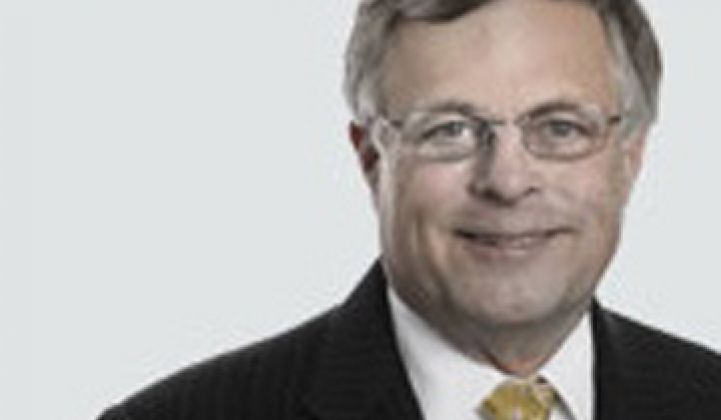As of today, SunPower founder Richard Swanson is officially retired.
Swanson, at age 67, said he's done with "14-hour days" and operations reviews and is ready to adapt to his new role as "elder statesman." Swanson remains with SunPower (SPWR) on its technical advisory board.
The arc of Swanson's career is a classic American success story.
Swanson received his Ph.D. in electrical engineering from Stanford University in 1974 and joined the Stanford faculty, where his group developed the point-contact solar cell. Lab versions set a record 28 percent conversion efficiency in concentrator cells and 23 percent in large-area one-sun cells. In 1991, Dr. Swanson resigned from the faculty to found and work at SunPower. The company had some lean times, raised capital from Silicon Valley entrepreneurs, notably T.J. Rodgers, become a technological powerhouse and moved downstream. SunPower's deal with French oil and gas conglomerate Total, kept the firm afloat and gave it backing.
Swanson went from Ph.D. science project to the world's energy stage.
The solar industry is transitioning, said Swanson. The current phase of "explosive growth" has been driven by investment capital from public markets and incentives from Germany and Italy. But in Swanson's words, "This is rapidly coming to an end." He called the subsidy regimes "fatigued."
The costs of solar are coming down so fast, "we're approaching grid parity." Swanson said that even with the Investment Tax Credit expiring at the end of 2016, the falling cost of solar will more than make up for that 30 percent reward. He declared, "We'll have weaned ourselves off of subsidies. We will have arrived as an industry."
SunPower's CEO Tom Werner compared Swanson to Gordon Moore of Intel and called him the Shockley of solar.
Werner said that "most mortals don't create a new solar design in a sleepless moment" that becomes, "with the help of a lot of engineers," SunPower's 22-percent-efficiency solar cell. Werner also pointed out that Swanson got into and stayed in solar when most of his peers moved to semiconductors.
"We're in a paradoxical time in the solar industry." Despite the "doom and gloom about excess capacity and depressed prices, nowhere else can you find a $100 billion industry growing at 20 percent a year," said Swanson at a recent IEEE event in Palo Alto, Calif.
"We have to figure out how to nurture a large, fast-growing industry," said Swanson.
Over the last year, as "President Emeritus" at SunPower (SPWR), Swanson has been involved with the low-concentration C7 tracker, the high-efficiency Maxeon solar cell, and SunPower's residential efforts in Japan. He has also worked with the DOE's SunShot program, looking to drive the cost of installed solar down below $1.00 per watt.
"From my perspective, the last ten years have been a rocket launch that exceeds any expectation," he said, adding, "There's been an overshoot, but signals do overshoot," according to the self-described "old electrical engineer."



